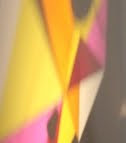when colors suggest sounds...

an image of a page from a 1967 japan architect magazine, featuring the interior color schemes for kyonori kikutake's pacific hotel. ikko tanaka, who devised the room colors writes about an attempt to use color in response to the cylindrical spiral basic forms of the hotel, and to create spaces "totally unlike the ones we daily experience".
tanaka describes the seven basic colors that make up the designs as "rainbow tones" and notes that, other than the wall colors, most of the colored elements can be moved from room to room to create new combinations - making the entire scheme of color combination somewhat modular.
the idea of modularity (shifting harmonic and dissonant relationships), as well as the use of the word "tones" to describe color, had me thinking about these images - these rooms - as potential scores for making sound. of course, the little color coded glockenspiels i used to generate the sound for siza's serpentine pavilion, and which i always have hanging around my studio, make perfect sense with tanaka's sense of color...
Labels: architecture, design, hotel interiors, japan architect, music, rainbow colors, synaesthesia


2 Comments:
hmmm people always seem to fall back on pitch/colour relationships, and i wonder if this is more cultural than cognitive (famous synaesthetes like kandinsky leave a long shadow). i would imagine these things to be much richer given the plurality of cultures kicking about. why not colour/timbre? why can't green sound like wasps??
i don't know if people tend to fall back on pitch/color relationships as much as there is such a long history of connecting such things. synaesthesia has connected the two for years to such a degree that most color dictionaries list a connected pitch equivalent. the thing that's interesting to me is that when i was doing research on a definitive list a few years ago, i found many sources that list note/color equivalents different than each other... proving a myriad of color and note connections rather than any absolutes. in the case of the rooms here and the pitch equavalents i think it's more of a connection between how the colors of the rainbow are used to allow kids to work with a kind of graphic notation (with the glocks) and the architect/designer working with relatively the same system (she even notes the use of seven colors - and of course one could move from there to a-g...).perhaps it is also the fact of referencing the colors as tones (not an uncommon term to enter dialogues on color). of course, no reason why green couldn't sound like wasps, or wasps sound like green... does debussy's la mer sound like the sea because of the combination of notes or because of cultural conditioning? perhaps in the case of wasp sounds it could be more connected to memory... a certain shade of color or light triggering a certain moment that is connected to a sound (or of course a smell or a taste). in terms of color scores/graphic notation, certainly colors have been used to represent any number of sounds or sound making activities beyond tone (although i've never seen one that refers to wasps :-). in this case, i simply liked the idea that a random discovery of a group of images of hotel interiors were color coded to match the tones on a kid's musical toy, which allows one to feel a connection between the image and the instrument as a potential for generating music.
Post a Comment
<< Home